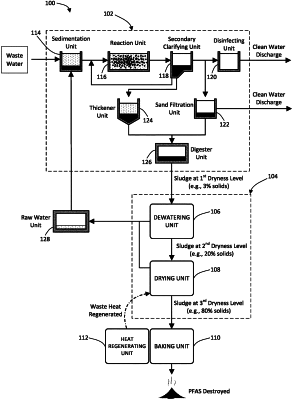| CPC C02F 9/00 (2013.01) [C02F 1/5236 (2013.01); C02F 1/5263 (2013.01); C02F 3/04 (2013.01); C02F 3/12 (2013.01); C02F 11/10 (2013.01); C02F 11/13 (2019.01); C02F 2101/36 (2013.01); C02F 2303/10 (2013.01)] | 18 Claims |

|
1. A method for remediating wastewater formed by water and per- and poly-fluoroalkyl substances (PFAS) using a wastewater treatment system, the method comprising the steps of:
providing said wastewater treatment system, the wastewater treatment system including a collecting unit, a dewatering unit, a drying unit, and a baking unit;
from a wastewater source, providing said wastewater to the collecting unit;
dosing the wastewater in the collecting unit by adding a compound to the wastewater in an amount that is sufficient to cause the PFAS to separate from the water and to form a sludge;
from the collecting unit, providing the sludge to the dewatering unit at a first dryness level having a first percent solids;
dewatering the sludge with the dewatering unit;
from the dewatering unit, providing the dewatered sludge to the drying unit at a second dryness level having a second percent solids, wherein the second percent solids is higher than the first percent solids;
drying the sludge with the drying unit;
from the drying unit, providing the dried sludge to the baking unit at a third dryness level having a third percent solids, wherein the third percent solids is higher than the second percent solids;
baking the sludge with the baking unit at a temperature that is between a minimum of 954° C. (1750° F.) to approximately 1600° C. (2912° F.) such that chemical bonds of at least a portion of the PFAS are destroyed.
|